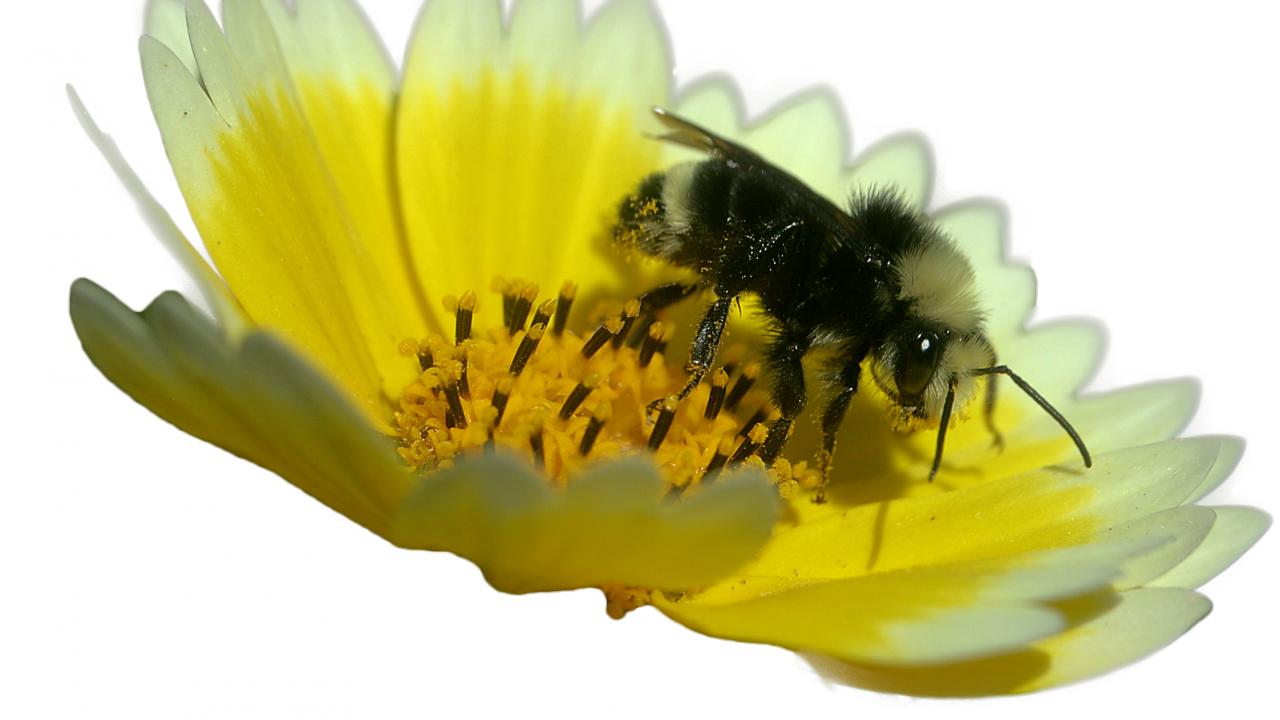
Beyond the honey bee: Learn more about California native bees
Why care about bees?
Bees are important as indicators of environmental quality, are key in the continued existence of our wildlands, vital to sustainable pollination of crops, and serve as food that supports a diversity of other species. In addition, bees are critical to the health of natural, ornamental and agricultural landscapes.
Beyond the honey bee
Most people can recognize non-native, ever- present European honey bees, but many are unaware of the 1600 species of native bee that can be found in California, many of them in our own gardens. While honey bees are social, live in hives and cooperate with one another, most of our native bees are solitary, live in wood or underground tunnels and do not make honey. The hard working females mate, make nests, collect pollen for their young and lay eggs. Males live to mate and only pollinate inadvertently when they visit flowers for nectar to fuel their flight. Native bees come in various shapes and sizes from the somewhat intimidating Valley carpenter bee at one inch long (sometimes more) to tiny sweat bees that are less than one quarter inch. They also vary in color, shape, markings on their faces and legs, distribution of hairs on their bodies and other features that may require a magnifying glass to be seen. Native bees differ in the seasons they appear, habitats they prefer, and flowers they favor.
Look for these bees and others in your outdoor spaces. They are all quite different from honey bees and each other.
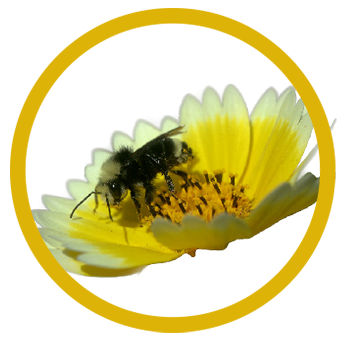
Yellow-faced bumble bee, Bombus vosnesenskii (Apidae)
Bumble bees move relatively slowly among flowers and are easy to recognize by their hairy chunky forms and yellow bands on their backs and abdomens. This hard-working species is one of the most common and easy to identify from its bright yellow facial hair. Female bumble bees’ hind legs widen to form pollen baskets often filled with bright colored, moistened pollen pellets.
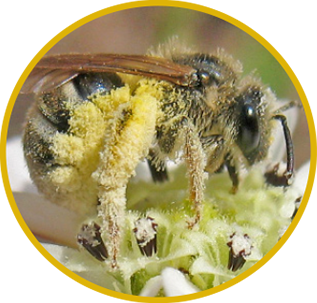
Sweat bee, Halictus spp. (Halictidae)
This is a group of medium to small elongate bees so named because of a tendency to alight on the skin and lap up sweat for moisture and salt. They are dark bees with pale hair bands at the ends of the abdominal segments giving a striped appearance. They typically carry pollen on their hind legs, but sometimes carry it on the underside of their abdomen. Common in our area, they nest in soil in annual colonies. (Photo Ken Schneider CC by-NC 2.0)
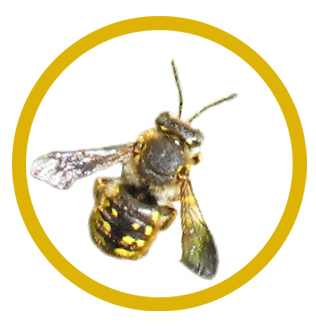
Wool carder bee, Anthidium manicatum (Megachilidae)
Although this bee is a non-native European introduction, it is common and easy to identify by its aggressive behavior and unusual abdominal striping — look for bands of color that do not quite meet in the middle. Males often set up territories and body slam other insects that get too close. Many curious insect watchers know them by a more appropo common name— head bonkers. They collect hairs from plants to build their nests (hence the common name) and often forage on Salvia plant species.
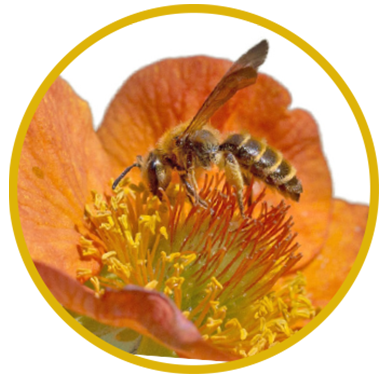
Mining bees, Andrena spp. (Andrenidae)
Medium to tiny bees, their populations peak from March to May as this group is among the first to emerge from their soil nests in spring. Many have metallic coloring and are characterized by grooves (facial foveae) that run down the center of their faces and between their compound eyes. They carry pollen on the upper part of their back hind legs (bees have three pairs of legs) as well as on the back sides of the insect’s mid-section (thorax).
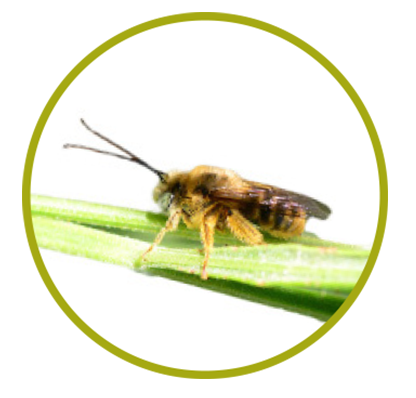
Long-horned bee, Melissodes spp. (Apidae)
Medium to large body bees, this group gets their names from the long antennae of the males. Females of this species do not have long antennae. Males may be seen by day jostling for female attention above a patch of plants like blanket flower (Gaillardia). Look closely at the diligent females collecting pollen. Both the males and the female of this species have hairy legs, but only the females have scopae (branched hairs) for carrying pollen.
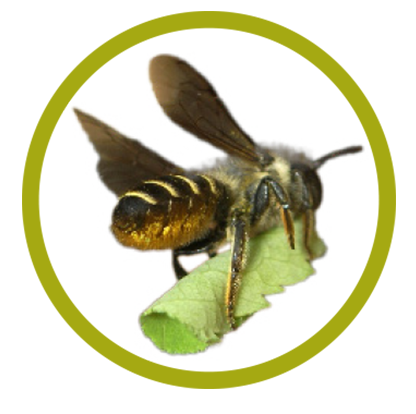
Leafcutter bee, Megachile spp. (Megachilidae)
These bees have triangular or heart-shaped abdomens, the underside of which is where their pollen carrying scopae are located. They are slow fliers with thick heads that hold muscles required for leaf cutting. They use the leaf material to partition their nests between eggs; most will nest in holes in wood. (Photo Rob Cruickshank CC by 2.0)
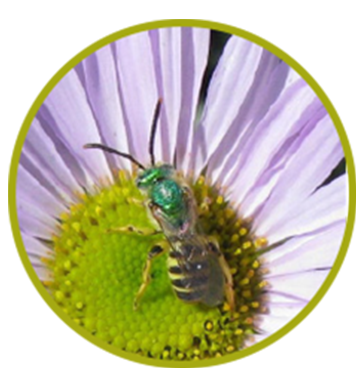
Ultra green sweat bee, Agapostemon texanum (Halictidae)
A remarkably colored insect, the females of this species are all metallic green, while the males are green on the head and thorax with a striped abdomen that makes them relatively easy to identify. You can find them in soil where they nest or on flowers in the daisy family (Asteraceae). Widespread and common, green sweat bees may be one of the first native bees you encounter, and one you will remember because of its jewel-like appearance.
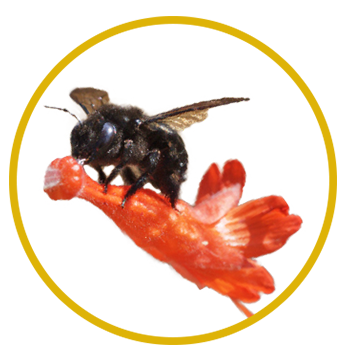
Valley carpenter bee, Xylocopa varipuncta (Apidae)
Called carpenter bees because they carve nests out of decaying wood or untreated lumber, the females of this species are large, stout, shiny black bee and one of the most noticeable bees found in Valley gardens. They can be commonly observed “nectar robbing” at the base of flowers where they pierce the flower tube to steal nectar. Solitary and long-lived, the females burrow into soft or decaying wood or pithy stems. Males of this species are affectionately referred to as “teddy bear bees” due to their golden bodies and hairs—if you are brave you can try and hold one—they are strong but cannot sting!

Mason bee, Osmia (Megachilidae)
Called masons because they use mud to create walls between their egg chambers, this species ranges in size and come in different colors from metallic blue to green. All mason bees have round abdomens, heads and thoraces as compared to other types of bees which have more oval shaped configurations. They also carry their pollen on the underside of their abdomens instead of their hind legs. The female of the common blue orchard mason bee (Osmia lignaria) has horns on her lower face while males commonly have dense mustache-like white hairs on their faces. Most species nest in preexisting cavities in wood.

Digger bee, Anthophora spp. (Apidae)
Aptly named, these species dig their nests in bare soil, so to welcome digger bees to your garden, leave some uncovered dirt in your landscape! This type of bee belongs to a larger group of bees that are generalist foragers but prefer plants in both the mint and the daisy families. They range in size but you can differentiate females by the long hairs on their hind legs (scopae) for carrying pollen and males by their unique, opal-like eyes.
Learn how to support our native bees with these 10 plants!
Click here to download a .pdf to get to know these 10 bees and 10 plants!
